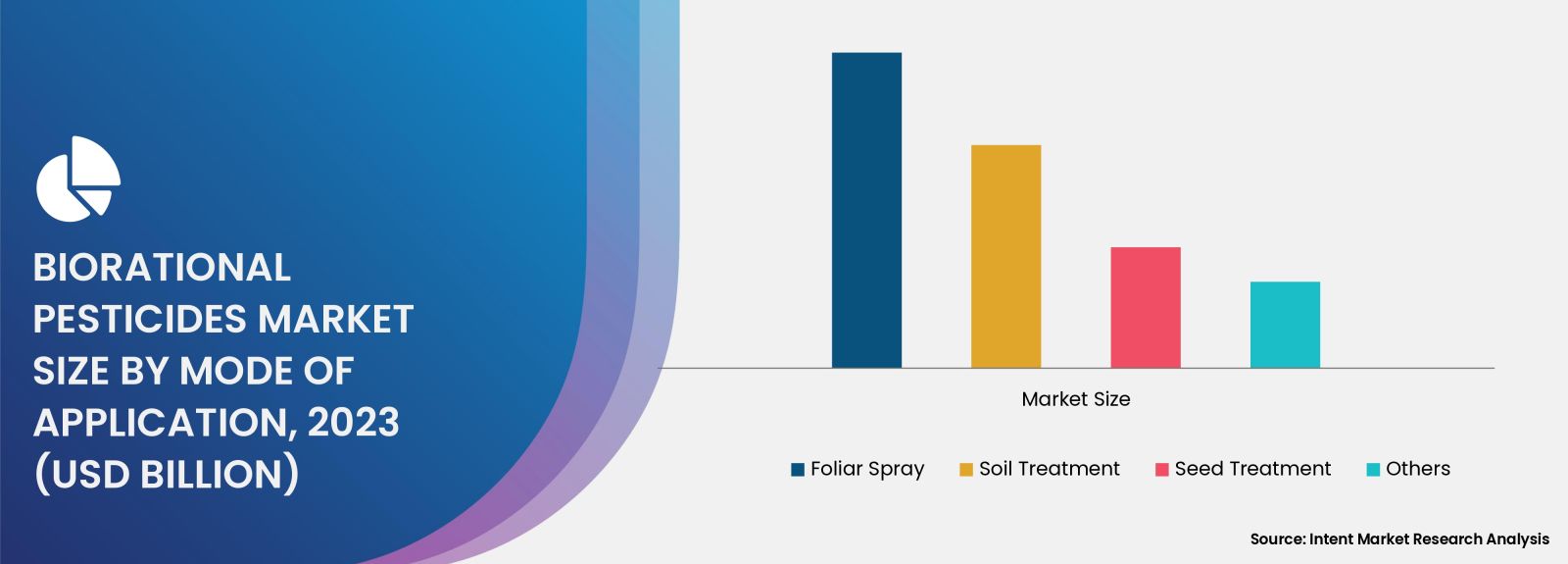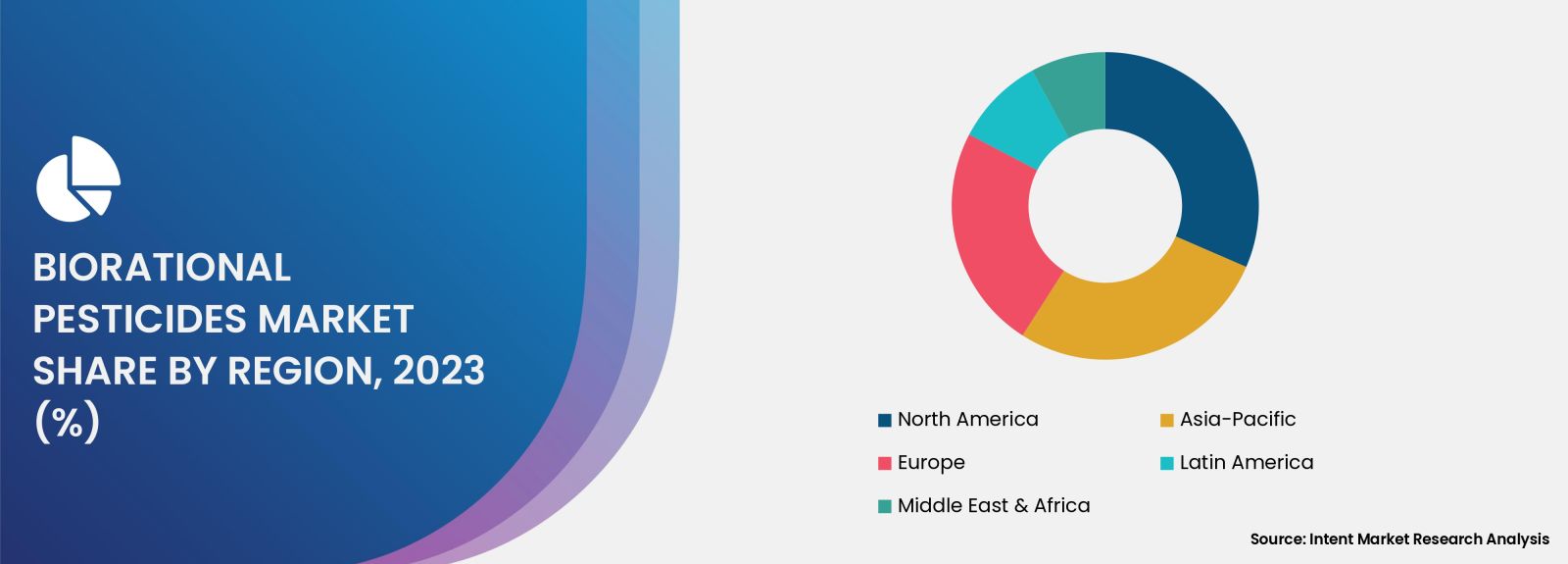As per Intent Market Research, the Biorational Pesticides Market was valued at USD 7.8 billion in 2023 and will surpass USD 19.6 billion by 2030; growing at a CAGR of 14.0% during 2024 - 2030.
Foliar Spray Segment is Expected to Witness the Significant Growth
In the biorational pesticides market, foliar spraying is a preferred method for its precision in targeting pests directly on plant leaves, where they are typically found. This approach ensures effective pest control, adhering to the principles of biorational pesticides, which emphasize eco-friendly, efficient, and specific pest management. By applying biorational pesticides directly to the foliage, foliar spraying enables a focused and efficient use of these solutions, minimizing harm to non-target organisms.

Asia Pacific is Projected to Have the Highest CAGR
The Asia Pacific region is expected to experience the highest CAGR, driven by the increasing adoption of eco-friendly pest control solutions. Japan's "Organic Village" initiative, led by the Ministry of Agriculture, Forestry, and Fisheries (MAFF), aims to boost the organic farming share to 25% by 2050, signaling a strategic move towards sustainable agriculture and contributing to the growing demand for biorational pesticides.
Similarly, China's emphasis on organic and sustainable farming practices, as outlined in its “14th Five-Year Plan for National Economic and Social Development,” focuses on strengthening green agricultural standards and certification management for organic and eco-friendly products. This shift toward sustainable agriculture is expected to increase demand for biorational pesticides in China, further fueling the growth of the Asia Pacific market.

The report focuses on estimating the current market potential in terms of the total addressable market for all the segments, sub-segments, and regions. In the process, all the high-growth and upcoming technologies were identified and analyzed to measure their impact on the current and future market. The report also identifies the key stakeholders, their business gaps, and their purchasing behavior. This information is essential for developing effective marketing strategies and creating products or services that meet the needs of the target market. The report also covers a detailed analysis of the competitive landscape which includes major players, their recent developments, growth strategies, product benchmarking, and manufacturing operations among others. Also, brief insights on start-up ecosystem and emerging companies is also included as part of this report.
Report Objectives:
The report will help you answer some of the most critical questions in the Biorational Pesticides Market. A few of them are as follows:
- What are the key drivers, restraints, opportunities, and challenges influencing the market growth?
- What are the prevailing technology trends in the Biorational Pesticides Market?
- What is the size of the Biorational Pesticides Market based on segments, sub-segments, and regions?
- What is the size of different market segments across key regions: North America, Europe, Asia-Pacific, Latin America, Middle East & Africa?
- What are the market opportunities for stakeholders after analyzing key market trends?
- Who are the leading market players and what are their market share and core competencies?
- What is the degree of competition in the market and what are the key growth strategies adopted by leading players?
- What is the competitive landscape of the market, including market share analysis, revenue analysis, and a ranking of key players?
Report Scope:
|
Report Features |
Description |
|
Market Size (2023) |
USD 7.8 billion |
|
Forecasted Value (2030) |
USD 19.6 billion |
|
CAGR (2024 – 2030) |
14.0% |
|
Base Year for Estimation |
2023 |
|
Historic Year |
2022 |
|
Forecast Period |
2024 – 2030 |
|
Report Coverage |
Market Forecast, Market Dynamics, Competitive Landscape, Recent Developments |
|
Segments Covered |
Biorational Pesticides Market By Type (Biorational Insecticides, Biorational Fungicides, Biorational Nematicides, Biorational Herbicides), By Source (Botanical, Microbials, Non-Organic), By Mode of Application (Foliar Spray, Soil Treatment, Seed Treatment), By Formulation (Liquid, Dry), By Crop Type (Fruits & Vegetables, Cereals & Grains, Oil Seeds & Pulses) |
|
Regional Analysis |
North America (US, Canada, Mexico), Europe (Germany, France, UK, Italy, Spain, and Rest of Europe), Asia-Pacific (China, Japan, South Korea, Australia, India, and Rest of Asia-Pacific), Latin America (Brazil, Argentina, and Rest of Latin America), Middle East & Africa (Saudi Arabia, UAE, Rest of Middle East & Africa) |
|
Customization Scope |
Customization for segments, region/country-level will be provided. Moreover, additional customization can be done based on the requirements |
|
1. Introduction |
|
1.1. Market Definition |
|
1.2. Scope of the Study |
|
1.3. Research Assumptions |
|
1.4. Study Limitations |
|
2. Research Methodology |
|
2.1. Research Approach |
|
2.1.1. Top-Down Method |
|
2.1.2. Bottom-Up Method |
|
2.1.3. Factor Impact Analysis |
|
2.2. Insights & Data Collection Process |
|
2.2.1. Secondary Research |
|
2.2.2. Primary Research |
|
2.3. Data Mining Process |
|
2.3.1. Data Analysis |
|
2.3.2. Data Validation and Revalidation |
|
2.3.3. Data Triangulation |
|
3.Executive Summary |
|
3.1. Major Markets & Segments |
|
3.2. Highest Growing Regions and Respective Countries |
|
3.3. Impact of Growth Drivers & Inhibitors |
|
3.4. Regulatory Overview by Country |
|
4. Biorational Pesticides Market, by Type (Market Size & Forecast: USD Million, 2022 – 2030) |
|
4.1. Biorational Insecticides |
|
4.2. Biorational Fungicides |
|
4.3. Biorational Nematicides |
|
4.4. Biorational Herbicides |
|
4.5. Others |
|
5. Biorational Pesticides Market, by Source (Market Size & Forecast: USD Million, 2022 – 2030) |
|
5.1. Botanical |
|
5.2. Microbials |
|
5.3. Non-Organic |
|
5.4. Others |
|
6. Biorational Pesticides Market, by Mode of Application (Market Size & Forecast: USD Million, 2022 – 2030) |
|
6.1. Foliar Spray |
|
6.2. Soil Treatment |
|
6.3. Seed Treatment |
|
6.4. Others |
|
7. Biorational Pesticides Market, by Formulation (Market Size & Forecast: USD Million, 2022 – 2030) |
|
7.1. Liquid |
|
7.2. Dry |
|
8. Biorational Pesticides Market, by Crop Type (Market Size & Forecast: USD Million, 2022 – 2030) |
|
8.1. Fruits & Vegetables |
|
8.2. Cereals & Grains |
|
8.3. Oil Seeds & Pulses |
|
8.4. Others |
|
9. Regional Analysis (Market Size & Forecast: USD Million, 2022 – 2030) |
|
9.1. Regional Overview |
|
9.2. North America |
|
9.2.1. Regional Trends & Growth Drivers |
|
9.2.2. Barriers & Challenges |
|
9.2.3. Opportunities |
|
9.2.4. Factor Impact Analysis |
|
9.2.5. Technology Trends |
|
9.2.6. North America Biorational Pesticides Market, by Type |
|
9.2.7. North America Biorational Pesticides Market, by Source |
|
9.2.8. North America Biorational Pesticides Market, by Mode of Application |
|
9.2.9. North America Biorational Pesticides Market, by Formulation |
|
9.2.10. North America Biorational Pesticides Market, by Crop Type |
|
9.2.11. By Country |
|
9.2.11.1. US |
|
9.2.11.1.1. US Biorational Pesticides Market, by Type |
|
9.2.11.1.2. US Biorational Pesticides Market, by Source |
|
9.2.11.1.3. US Biorational Pesticides Market, by Mode of Application |
|
9.2.11.1.4. US Biorational Pesticides Market, by Formulation |
|
9.2.11.1.5. US Biorational Pesticides Market, by Crop Type |
|
9.2.11.2. Canada |
|
9.2.11.3. Mexico |
|
*Similar segmentation will be provided for each region and country |
|
9.3. Europe |
|
9.4. Asia-Pacific |
|
9.5. Latin America |
|
9.6. Middle East & Africa |
|
10. Competitive Landscape |
|
10.1. Overview of the Key Players |
|
10.2. Competitive Ecosystem |
|
10.2.1. Level of Fragmentation |
|
10.2.2. Market Consolidation |
|
10.2.3. Product Innovation |
|
10.3. Company Share Analysis |
|
10.4. Company Benchmarking Matrix |
|
10.4.1. Strategic Overview |
|
10.4.2. Product Innovations |
|
10.5. Start-up Ecosystem |
|
10.6. Strategic Competitive Insights/ Customer Imperatives |
|
10.7. ESG Matrix/ Sustainability Matrix |
|
10.8. Manufacturing Network |
|
10.8.1. Locations |
|
10.8.2. Supply Chain and Logistics |
|
10.8.3. Product Flexibility/Customization |
|
10.8.4. Digital Transformation and Connectivity |
|
10.8.5. Environmental and Regulatory Compliance |
|
10.9. Technology Readiness Level Matrix |
|
10.10. Technology Maturity Curve |
|
10.11. Buying Criteria |
|
11. Company Profiles |
|
11.1. BASF |
|
11.1.1. Company Overview |
|
11.1.2. Company Financials |
|
11.1.3. Product/Service Portfolio |
|
11.1.4. Recent Developments |
|
11.1.5. IMR Analysis |
|
*Similar information will be provided for other companies |
|
11.2. Bayer AG |
|
11.3. FMC Corporation |
|
11.4. Koppert |
|
11.5. Novozymes A/S |
|
11.6. Pro Farm Group |
|
11.7. Sumitomo Chemical Co., Ltd |
|
11.8. Syngenta |
|
11.9. UPL |
|
11.10. Valent U.S.A. LLC |
|
12. Appendix |
A comprehensive market research approach was employed to gather and analyze data on the Biorational Pesticides Market. In the process, the analysis was also done to analyze the parent market and relevant adjacencies to measure the impact of them on the Biorational Pesticides Market. The research methodology encompassed both secondary and primary research techniques, ensuring the accuracy and credibility of the findings.
.jpg)
Secondary Research
Secondary research involved a thorough review of pertinent industry reports, journals, articles, and publications. Additionally, annual reports, press releases, and investor presentations of industry players were scrutinized to gain insights into their market positioning and strategies.
Primary Research
Primary research involved conducting in-depth interviews with industry experts, stakeholders, and market participants across the Biorational Pesticides ecosystem. The primary research objectives included:
- Validating findings and assumptions derived from secondary research
- Gathering qualitative and quantitative data on market trends, drivers, and challenges
- Understanding the demand-side dynamics, encompassing end-users, component manufacturers, facility providers, and service providers
- Assessing the supply-side landscape, including technological advancements and recent developments
Market Size Assessment
A combination of top-down and bottom-up approaches was utilized to analyze the overall size of the Biorational Pesticides Market. These methods were also employed to assess the size of various subsegments within the market. The market size assessment methodology encompassed the following steps:
- Identification of key industry players and relevant revenues through extensive secondary research
- Determination of the industry's supply chain and market size, in terms of value, through primary and secondary research processes
- Calculation of percentage shares, splits, and breakdowns using secondary sources and verification through primary sources
.jpg)
Data Triangulation
To ensure the accuracy and reliability of the market size, data triangulation was implemented. This involved cross-referencing data from various sources, including demand and supply side factors, market trends, and expert opinions. Additionally, top-down and bottom-up approaches were employed to validate the market size assessment.
NA
